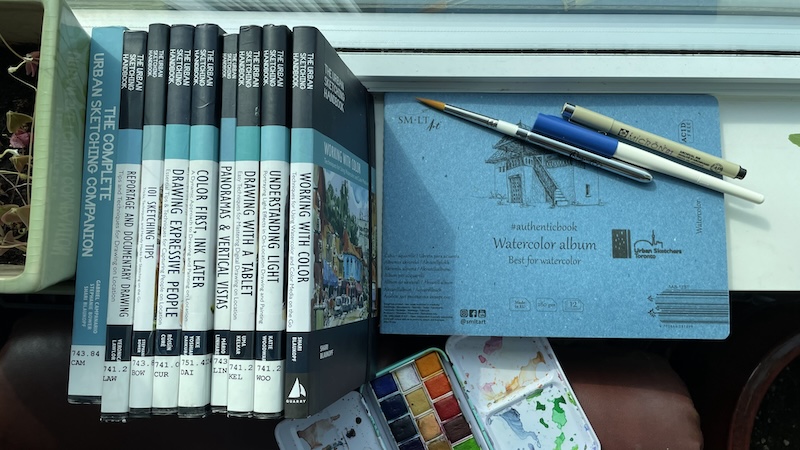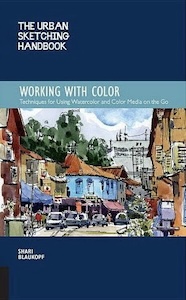
I’ve really gotten into urban sketching over the last number of years, as it really speaks to my love of buildings and cityscapes (especially when I was travelling more in 2018/2019), as well as the looser style of painting that I enjoy. And after attending the Toronto Urban Sketchers 10×10 Workshop weekend back in July of this year, it really rejuvenated my love of it. I owned one of the Urban Sketching Handbooks already, and checked out a bunch more from the local library (and have since purchased a few of the ones I particularly found helpful). Here, I wanted to do a little review of each of them that I read, in hopes that others find it helpful to what they may be looking for in their own work.
Whether you’re new and wanting to learn the basic techniques or a seasoned sketcher looking to hone some skills, there’s probably something in these books for everyone.

Working with Color: Techniques for Using Watercolor and Color Media on the Go by Shari Blaukopf
This book was great for basics of colour theory (primary, secondary, complementary, etc.) but, even better, it included paint combinations to achieve the corresponding painting examples.
I loved how Shari breaks down these are the 2 or 3 colours you mix to get this stormy sky, or if you want a sunset, this is what you should do. How to get variations on the same colour (ie. green) if the majority of your scene is foliage.
Really helpful handbook that I’m sure I’ll go back and refer to!
Review: ★ ★ ★ ★ (4 /5 stars)

Reportage and Documentary Drawing: Tips and Techniques for Drawing on Location by Veronica Lawlor
The title of this includes “tips and techniques for drawing on location” but I personally found there really wasn’t much of either.
This was more of a collection of different artists’ artwork, which – sure – was great to see and get inspiration from, but other than some very basic common sense suggestions (“draw food!”, “draw a parade!”, “draw at a party!”), it really wasn’t offering any techniques or HOW to do it.
Great for inspiration, but not if you’re looking for instruction.
Review: ★ ★ (2 /5 stars)

101 Sketching Tips: Tricks, Techniques, and Handy Hacks for Sketching on the Go by Stephanie Bower
I was curious how in-depth this would get to share 101 tips in such a compact book but there were a lot of fantastic nuggets of tips and techniques! So much so that I picked up a copy after returning my library one.
I particularly loved the section about the “a-ha moments” (starting at tip 77), where Stephanie breaks down how to tackle curves, archways, domes, towers, etc. I took down a lot of notes and looking to put it into practice! This was a really great, really well-explained handy reference book.
Review: ★ ★ ★ ★ ★ (5 /5 stars)

Drawing Expressive People: Essential Tips & Techniques for Capturing People on Location by Róisín Curé
This is always a tricky part for my urban sketching, and I often do leave out people but I found the challenge to try and draw people quickly really fun. I even sat by my window one morning and tried to quickly sketch the people that passed by.
While there are examples from other artists in the gallery section at the end, the rest of the book felt sporadic in examples of the actual techniques. the author/artist is clearly very talented and I did love seeing all her own examples of the techniques but would have maybe liked a bit of variation too for people to see other ways of tackling what she’s teaching. I liked the chart of showing the mixes to achieve most skin tones, the tips on how you can capture the key important elements quickly.
Review: ★ ★ ★ ☆ (3.5 /5 stars)

Panoramas and Vertical Vistas: Techniques for Drawing on Location from Unexpected Perspectives by Mário Linhares
There were some good tips on how to tackle panoramas or vertical extremes, also some different techniques on how to tackle expansive scenes.
I found most of the book though a showcase of examples, which were great to see different styles and approaches, but it wasn’t as much technical instruction as I would have hoped. It was a lot of “try focusing on one thing in the foreground and building out around it!” or “Try drawing a vertical line first”.
I did like all the fold-out pages to really be able to show the panorama examples.
Review: ★ ★ ★ (3 /5 stars)

Understanding Light: Portraying Light Effects in On-Location Drawing and Painting by Katie Woodward
This ended up being much more helpful than I initially thought it would be. I (wrongfully) assumed I knew the basics of light but this was a great resource where it breaks down all the ways to look at a scene and how the shadows and reflections hit. Great tips on tackling foliage, different atmospheric scenarios and night scenes.
I think the majority of the examples shown in this were of the author’s, but I love Katie Woodward’s artwork (especially as she often paints NYC scenes), so I didn’t mind that in this instance.
I only wish perhaps that there was more techniques on how to achieve all these things to take note of. There are tips to keep in mind, and ways to tackle it but I guess it is definitely more what the title says: UNDERSTANDING Light.
Review: ★ ★ ★ ★ ☆ (4.5 /5 stars)

Color First, Ink Later: A Dynamic Approach to Drawing and Painting on Location by Mike Yoshiaki Daikubara
I love Ian Fennelly’s work and was excited to read Mike Daikubara’s handbook too. I have been looking forward to reading this one as this is exactly my style and approach to urban sketching (until recently when I was learning to do it the “traditional” way). And Mike talks about this too – how some scenarios (with less time) will still warrant the sketch first, colour later method.
This was fantastic because not only does he explain the techniques, he gives rough times for each stage, and shows multiple examples of step by step on how he created his colour first/ink later paintings.
I originally borrowed this book from the library but I definitely bought a copy for myself to have on hand for future reference. This is going to enhance and improve on my style for sure.
Review: ★ ★ ★ ★ ★ (5 /5 stars)

Drawing with a Tablet: Easy Techniques for Mastering Digital Drawing on Location by Uma Kelkar
This book’s content fell between two extremes, that I personally did not find very useful in either spectrum. It offered relatively “basic” information on the different features and tools available on Procreate so more experienced users wouldn’t be learning anything new, but it also talked about these tools and terminology in a way that a brand new user may not easily follow.
I enjoy Uma’s artwork, and there were some great examples from many artists of different styles of digital urban sketching, however other than the explanations of using layers, and playing with colours and brushes/textures, it doesn’t really quite explain much. It’s tough to write a book about a medium that’s constantly evolving, with so many variables and options (too many! for me).
Review: ★ ★ (2 /5 stars)

Essential Concepts and Techniques from The Urban Sketching Handbooks – Architecture and Cityscapes, Understanding Perspective, People and Motion, and Working with Color by Shari Blaukopf, Stephanie Bower, Gabriel Campanario
This book is thicker than the other Urban Sketching Handbooks in the series. It’s a compilation of four existing books, with about half the content, included in this companion book.
(i.e. each book normally is 112 pages each, so this one is roughly about 56 pages each of the four volumes: Architecture and Cityscapes, Understanding Perspective, People and Motion, and Working with Color – which I had already read).
I found the information that was covered really handy, especially the perspective one. I always struggle with perspective and proportions and this one gave a lot of exercises and techniques to try and do it properly!
The biggest thing I didn’t love was the binding. Because it’s thicker, and the way it’s bound, unless I cracked the spine to force it to lay flat, it was thick and heavy to hold or prop open while I tried to do the sketching exercises. The regular handbooks lay flat easily and much better to use as reference. I was definitely intrigued enough to buy the full 112 pages of just the Understanding Perspective one!
Review: ★ ★ ★ ★ (4 /5 stars)